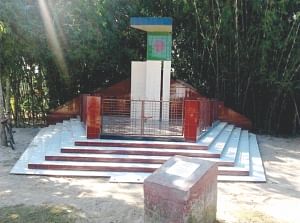| Home - Back Issues - The Team - Contact Us |
 |
| Volume 10 |Issue 44 | November 25, 2011 | |
|
|
History Remembering the Hatia Massacre ABDUL WAHED November 13 is a tragic massacre (genocide) day for the people of Hatia union under Ulipur upazila of the district. It was the largest genocide in Rangpur during the liberation war. The Pakistani army killed 697 people, including freedom fighters, in the Hatia union on this day of 1971. Every year, people of Hatia union and concerned organisations observe the day with deep respect. To mark the day, this year, the people made a five-point demand, including the rehabilitation of the martyrs' families by the government.
On November 13, 1971, when we were still fighting to free the country, one of the largest mass killings took place in Dagar Kuthi village of the Hatia union. The Pakistani army, aided by Razsakars, killed 697 people including five freedom fighters. The invaders burned down houses and tortured women during the mass killings. The five martyred freedom fighters were Golzer Hossen, Hitendra Nath, Montaj Ali, Abul Kasem Kachu and Nawab Ali. Hatia union, which is near the Brahmaputra River, was under Mankerchar Sub-sector of Sector No. 11 during the liberation war. There were many residences of freedom fighters in the Hatia union. Freedom fighters had set up camp here. Local people assisted the freedom fighters with food and shelter. Hatia people fought against the Pakistan supporters alongside the freedom force. Local agents (Rajakar, Albadar and Al-Shams) of Pakistani army informed the Pak army about the freedom fighters' shelter. On November 13, 1971 (the 23rd day of Ramadan), the Pak invaders attacked the union just before sunrise, when people had gone to bed after taking sehri. Bullets fell like rain on the people and houses when they slept. The seven villages attacked by the Pak army are Anantapur, Rumkhana, Naya Doba, Bagua, Nilkhata, Dagar Kuthi and Hatia. Some of them were brought to the killing spot (Boddho Bhumi) at Dagar Kuthi village and shot dead. Some people were burned alive. Some dead bodies were thrown in the nearby Brahmaputra River. Others were dumped in unmarked graves by near the bank of the river. After liberation, the Dagar Kuthi village was washed away due to river erosion. The village has re-emerged over the last two years as shoal. Locals call the village Char Dagar Kuthi. On the doomed day, the freedom fighters were caught unawares by the early morning ambush. The freedom fighter sources said that the names of 412 martyrs have been collected. The rest of the martyrs' names will be collected as soon as possible. To remember these brave souls of the liberation war, a martyr memorial (smriti shoudho) had been constructed in Dagar Kuthi village, which was lost due to erosion by the Brahmaputra River. Later, a smaller version of the memorial was constructed at the Hatia union Parishad grounds, but it is in desperate need of adequate upkeep. To mark the day this year, the upazila Mukti Joddha Sangshad unit, Bagua Ennoblement Students' Troop (BEST) and Hatia union parishad jointly took a day-long programme, including flag hoisting, rally, discussion-meeting and prayers. The discussion meeting and prayers for the dead were held in the new memorial premises near Anantapur Bazar. Convener of the day, celebration committee and Hatia union parishad chairman, Md. Abul Hossen says, “Almost all martyrs' families are poor and affected by erosion. Relatives of the martyrs are demanding exemplary punishment of war criminals, highlighting the real history of the liberation war of 1971 and saving Hatia union from erosion by the river Brahmaputra.” “We have taken preparation locally to observe the day. We are demanding five things this year: rehabilitating the martyrs' families of the Hatia genocide, national acceptance of November 13 as Hatia genocide day, observing the day by local administration, marking the Baddha Bhumi (killing spot) in the Char Dagar Kuthi village and saving Hatia union from erosion by the river Brahmaputra”, he adds. Hatia may be an impoverished union where people continue to bear the legacy of river erosion. But it is the place where forty-one years ago, valiant freedom fighters and innocent villagers had to give up their lives before tasting the sweetness of freedom. The writer is The Daily Star's Kurigram correspondent.
Copyright
(R) thedailystar.net 2011 |
